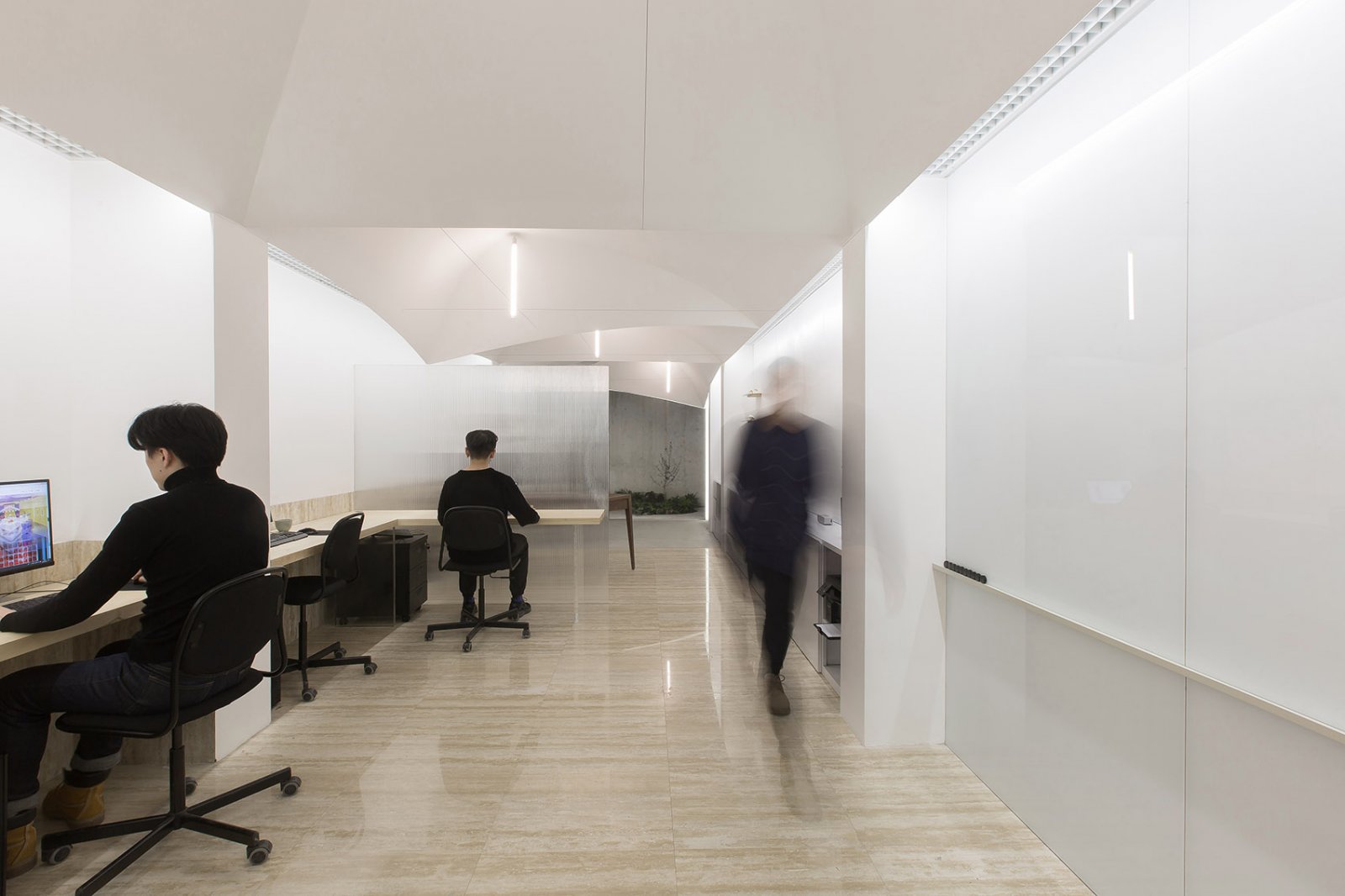The MaoHaus AntiStatics Architecture
2018-01-05 01:00
毛豪斯是一个实验性的外观作品,探索历史背景,材料潜力,新的制造和表演品质的建筑。以现有结构的简单框架和边缘条件,立面作为流动的织物进入胡同的空间。这种流动性是通过传统的僵化材料来表达的,它通过形式表达来质疑固有的物质观。在起伏的形状之外,表面的穿孔起到了过滤光线的作用,白天,阳光进入前厅,晚上,精确调谐的光缝显示出毛主席的原型肖像的三叶草。毛主席在门面上的表达是对遗址历史背景的一种肯定。作品位于北京市中心的胡同小巷,毗邻人民艺术之家印刷店,这个工作室曾经是主席现在的标志性形象的主要制作者之一。
MaoHaus is an experimental façade piece exploring historical context, material potentials, novel fabrication and performative qualities within architecture. Taking the simple frame and edge condition of the existing structure, the façade enters the space of the hutong as a flowing fabric. This fluidity is expressed through the conventionally rigid material of concrete questioning inherent perceptions of materiality through formal expression. Beyond the undulating form, the perforations of the surface serve to filter light, during the day, rays of sunlight enter the vestibule, and at night the precisely tuned apertures reveal a triptych of Chairman Mao’s prototypical portrait. The expression of Chairman Mao within the façade is a nod to the historical context of the site. The work is located in a Hutong alley in central Beijing adjacent to The People’s Art House Print Shop, this workshop was once one of the primary producers of the Chairman’s now iconic image.
MaoHaus Exterior. Image © Xia Zhi
Concept Diagram. Image Courtesy of AntiStatics Architecture
MaoHaus Night. Image © Xia Zhi
立面的结构利用超高性能混凝土的材料特性,创造出新颖的建筑形式。从4米到7米高,2米宽,只有7厘米厚,6个单独的面板横跨的外观,不需要任何子结构或支撑。每个面板都是由大型数控铣削模具制成的单一单元。通过流体力学算法计算,薄多孔表面的曲率可以更有效地将结构的荷载传递给地基。
The structure of the façade leverages the material properties of ultra-high performance concrete to create novel architectural form. Ranging from 4 to 7 meters in height, 2 meters wide and a mere 7 centimeters thick, the 6 individual panels span the façade without the need for any substructure or support. Each panel is cast as a single unit from large CNC milled molds. Computationally generated through fluid-dynamics algorithms, the curvature of the thin porous surface serves to more efficiently carry the loads of the structure to the foundation.
MaoHaus Exterior. Image © Xia Zhi
MaoHaus Detail. Image © Xia Zhi
穿过地面的孔阵列在设计、结构完整的重量消除、意象和历史背景的表达,以及在胡同小巷狭小空间内与用户互动方面发挥着多种作用。与曲线曲面一致,孔洞与空间中的某一特定区域相一致。网站访问者将根据其相对位置和访问时间与外观体验和互动非常不同。从某些有利的角度看,外观被明显地压平,显示了嵌入的图像,而从其他角度看,它可能被解读为流动的旗帜,冻结在时间里。
The array of apertures across the surface play several roles within the design, removal of weight for structural integrity, expression of imagery and historical context and also as a means of interacting with the user within the tight space of the hutong alley. In unison with the curvilinear surface, the apertures align themselves to a particular region in the space. Visitors to the site will experience and interact with the façade very differently depending on their relative position as well as time of visit. From certain vantages, the façade is perceptibly flattened revealing the embedded image, while from other points it may read as flowing banner frozen in time.
MaoHaus Interior. Image © Xia Zhi
毛豪斯试图在一个单一的表达中探索各种屈尊的要素。展望新的材料创新,外观推进了从看似传统的建筑材料所能达到的极限。为了寻求一个多方面的设计,毛豪斯的存在是一个综合的材料特性,定制的计算工具和生成与历史的参考,上下文和表达。
MaoHaus seeks to explore various elements of deign within a singular expression. Looking to new material innovation the façade pushes the limits of what may be achieved from seemingly conventional architectural materials. Seeking a multifaceted design, MaoHaus exists as a synthesis of material properties, customized computational tooling and generation with historical reference, context and expression.
MaoHaus Site. Image © Xia Zhi
 举报
举报
别默默的看了,快登录帮我评论一下吧!:)
注册
登录
更多评论
相关文章
-

描边风设计中,最容易犯的8种问题分析
2018年走过了四分之一,LOGO设计趋势也清晰了LOGO设计
-

描边风设计中,最容易犯的8种问题分析
2018年走过了四分之一,LOGO设计趋势也清晰了LOGO设计
-

描边风设计中,最容易犯的8种问题分析
2018年走过了四分之一,LOGO设计趋势也清晰了LOGO设计
















































































































































